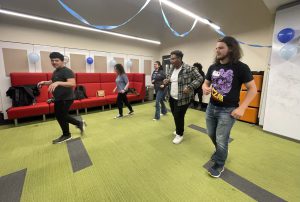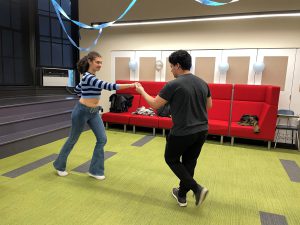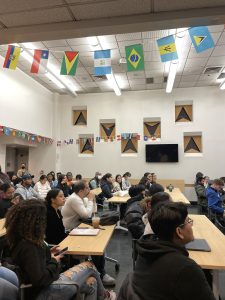
Salsa music can be heard blaring from room TH 208/209 as students are greeted with blue streamers and a banner that reads “Latino Medical Student Association” just above the entrance. They’re gathered here for LMSA+’s “Salsa Night” where the club’s vice president, Stevens Patino, is teaching them salsa. Most of the students attending are of Latine descent, from places like Puerto Rico, Mexico, Brazil, Peru, and the Dominican Republic just to name a few. They can be seen dancing with each other and sharing other traditional dances as the night goes on.
Like other CUNY schools, Hunter is known to attract a diverse student body from across New York City and beyond. According to Data USA, about 28.6 percent of Hunter students are of Hispanic/Latine descent as of 2020. They edge out their white peers by 0.1 percent, who make up 28.5 percent of the student population. However, the amount of Hispanic/Latine student organizations are not reflective of these statistics. LMSA+, for instance, is one of only three Hispanic/Latine-centered clubs listed on Hunter’s website.
“I’ve looked for other Latino clubs and I [had] difficulty finding them,” said Patino. “I think what we have here is a hidden gem.”
Students like Patino expressed having difficulty forming connections with fellow Latine students. A major factor of this is Hunter’s reputation as a commuter school, where many students mainly come to campus for classes and then leave once they’re done. This has led to a lack of awareness of events or clubs that center their heritage. Orquidea Recendez, a second-year transfer student from California, said that the only Hispanic/Latine event she’s attended was for Día de los Muertos last fall. She added that if she hadn’t been taking Spanish, then she wouldn’t have known about it.
“I feel like with my busy schedule I don’t really spend much time in school unless I really need to,” said Recendez.

Monica Schinaider, a Spanish professor from the Romance Language Department, found that there’s a need for more community-building among Latine students. She coordinated the event “Spanish as Language Engagement Day” to engage with students and to inform them on what the department offers them. It was also a cultural celebration where students expressed themselves through poems, music, presentations, and more. Schinaider invited eight sections of heritage learner classes to attend.
Schinaider also noted the importance of networking and how a lack of engagement can be detrimental to that. Part of the issue is lack of communication between Hunter and the student body, which was exacerbated after classes went online due to the COVID-19 pandemic. Schinaider said that her department does its best to reach out to students and is active in terms of events. They’re also trying to extend their outreach to students who aren’t Spanish majors or minors, as they could benefit from knowing about their services as well.
“We need more communication among the groups of the Latinos and the Spanish community,” said Schinaider. “I know that there are things going on, but we do not interact and we do not communicate [with] each other.”
Hunter USG’s Cultural Affairs Commissioner Asia Akperov also cited lack of communication as a wider issue at the school that prevents students from learning about and attending these events. Akperov, whose role is to help charter and manage clubs, said that USG has tried to reach students through social media and email but not everyone checks them. She does know that there is a demand for Hispanic/Latine-centered activities based on students’ responses and prior success, such as their Hispanic Heritage Month event last October.

Akperov also pointed out that students often need an incentive to attend events considering the commuter aspect of Hunter. She thinks in this sense USG needs to do a better job advertising them and rallying the students in. Recently, they’ve been brainstorming on ways to engage with students, such as posting flyers with QR codes or emailing professors to relay event details to their students.
Akperov said that her and the rest of USG are always open to hearing from clubs and students on how they can improve on “centering Hispanic voices and other marginalized communities” throughout the whole year, not just for one event.
“It’s just so important for students to come together, specifically at events where there’s food, there’s music, and there’s peers,” said Akperov. “That is where community building happens, and oftentimes doesn’t happen in classrooms.”

